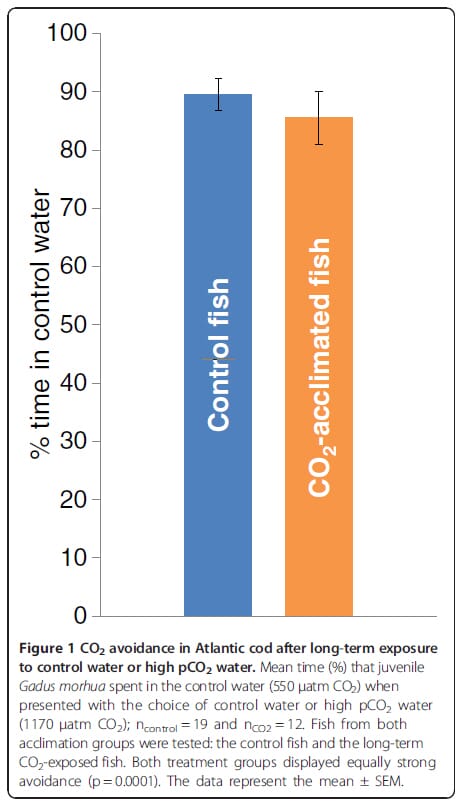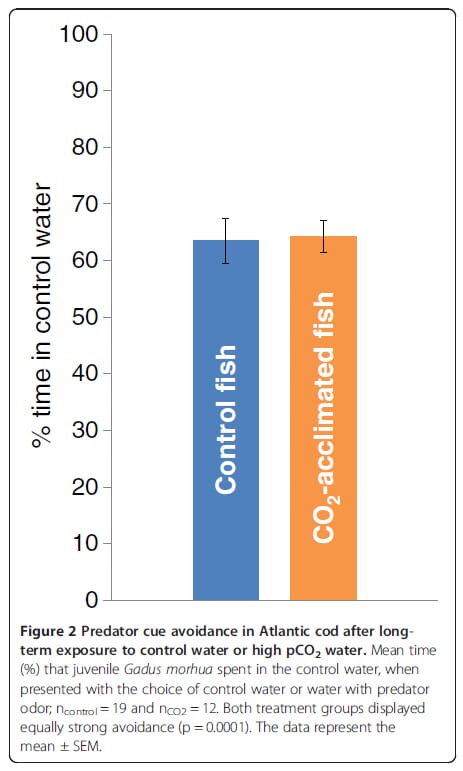Human activities are causing the release of CO2 into the atmosphere at increasing rates [1], resulting in a higher oceanic surface partial pressure for CO2 (pCO2) and a decrease in the pH in a process termed ocean acidification.
Currently (may 2013), the levels have reached 400 ppm [2] and could reach 1000 ppm by the year 2100 (the fossil fuel intensive IPCC A1F1 emission scenario [1]), which will result in ~1000 μatm CO2 in the surface water [3].
A growing number of reports suggest that the behaviour of coral reef fishes may be highly affected by ocean acidification (see review by Briffa et al. [4]). The behavioural effects appeared at CO2 levels predicted by some emission scenarios (700–1200 μatm). A switch from repulsion to attraction to the scent of predators has been observed in several coral reef fish species after CO2 exposure.
Damselfish larvae became attracted to the smell of predators at 700 μatm, and the larvae completely lost the ability to sense predators at 850 μatm [5]. A similar effect was observed in juvenile coral trout; when the fish were reared in 965 μatm CO2, they spent 90% of their time in the predator odour [6]. While the reversing effect of CO2-exposure on predator avoidance appears to be common in coral reef fish, it is still unknown if this is ubiquitous in teleosts from other parts of the world.
In order to optimize factors such as temperature, light, food availability and predator density [7], fish navigate through heterogeneous marine environments using many cues [8]. Teleosts employ external chemosensory receptors [2,9], possibly neuroepithelial cells located on the gills [1,10], to detect the ambient CO2 concentration.
The physiological responses to acute exposure to elevated CO2 have been reasonably well described, and include bradycardia, hypertension and hyperventilation [3,11-13]. However, how fish behaviour, distribution and migration might be affected by a heterogeneous CO2 environment
has received less attention [4,14]. It is known that teleosts avoid water with very high pCO2 [5,15], and freshwater Arctic charr (Salvelinus alpinus) demonstrated attraction to low concentrations of CO2 but avoided higher concentrations of CO2 in a gradient tank [6,16].
How marine fish behave when presented with the choice of the relatively small concentration gradient of present-day pCO2 and a future scenario pCO2 is unknown. It is also unknown whether and how long-term exposure and acclimation to elevated CO2 levels will influence behavioural choices [7,14,17]. The issue of CO2 avoidance behaviour in fish has been highlighted as a
concern that experimental biologists should investigate, in a review of possible effects of ocean acidification on fish [8,14]. If marine fish navigate using small differences in pCO2, then the increasing pCO2 due to anthropogenic disturbance could potentially affect the movement
patterns and migrations of fish in the future ocean. For example, areas with heavy macrophyte growth can already reach high CO2 levels during the night [18]. With an increased baseline CO2 level from ocean acidification, the nightly increase in pCO2 in the local microclimate of macrophyte beds could become irritant to some fishes and lead to avoidance of sheltered areas [18].
We investigated whether the ecologically and economically important teleost Atlantic cod actively discriminate between control CO2 and elevated CO2 levels (1000 μatm), and if this behaviour is modulated by longterm exposure to CO2. Furthermore, we tested whether exposure to CO2 cause cod to lose the ability to avoid olfactory cues from predators.
Results
The fish from the control group actively avoided CO2- enriched water (p < 0.0001). The CO2-exposed fish demonstrated equally strong avoidance behaviour to CO2 (p < 0.0001). There was no significant difference between the control fish and CO2-exposed fish in the strength of
avoidance behaviour (p = 0.482, ncontrol = 19, nCO2 = 13) (Figure 1).
In the predator avoidance test (Figure 2), both the control fish and the CO2-exposed fish avoided the water coming from the header tank that contained a potential predator (pControl fish < 0.0001 and pCO2 fish <0.0001). There was no significant difference in the strength of the avoidance behaviour between treatments (nested ANOVA; p = 0.481, ncontrol = 18, nCO2 = 13).

Discussion
Increased CO2 concentrations in the water can elicit sensory responses in fish [10,13,19] as well as physiological responses [1,12]. However, it has been unclear whether near-future CO2-levels can provoke avoidance behaviour in marine fish. In this study, we demonstrated that juvenile Atlantic cod strongly avoided water containing increased pCO2 (1000 μatm) in favour of water
containing the control CO2 concentration (500 μatm). The fish spent 90% of their time in the control water, indicating that elevated pCO2 is highly undesirable for young cod.
Surprisingly, the long-term acclimated cod showed the same level of avoidance behaviour as the control fish. This finding suggests that despite the possible acclimation and habituation processes, the cod still considered the high pCO2 water as suboptimal and avoided it. Repeated exposure to a sensory stimulus can lead to habituation, and the response to subsequent exposures to the same stimuli has a decreased magnitude [20]. The fish were under constant exposure to high pCO2 for over one month, which could theoretically have induced habituation or a shift in the baseline of what is categorized as “normal” for the fish, which would have led to a lower level of avoidance of or possibly even a preference for high CO2. Because habituation was not detected, it is possible that the habituation of sensory systems to high CO2 is a very slow or nonexistent process in fish.
It has been suggested that any CO2 avoidance behaviour in fish could affect their distribution, migration patterns and, therefore, the marine ecosystem structure [6,14]. Theoretically, fish could avoid areas of high pCO2 and actively seek out lower pCO2 waters over both long and short timescales. Daily migrations could be affected in areas with high biomass because the pCO2 could
already be high because of net respiration during darkness [18,21,22], and combined with ocean acidification, this could drive the CO2 levels into the avoidance range for cod.

Pelagic fish normally avoid the mesopelagic oxygen minimum zone, and hypoxia has been suggested as the repellent [7,23,24]. However, these hypoxic zones are also associated with high pCO2 [8,25,26], which suggests that the avoidance behaviour against oxygen minimum zones observed in nature [9,25] could be associated with high pCO2 as well as hypoxia. Because of the close association of hypoxia with hypercapnia in nature, fish may also use hypercapnia as a proxy for harmful oxygen levels despite being tolerant to the CO2 itself. While it is too early to draw firm conclusions regarding the ecological relevance of the CO2 avoidance behaviour in marine fish, the subject deserves more attention.
Because CO2 exposure reverses the preferences to olfactory cues in several coral reef teleost species, as well as affects the behaviour of temperate sticklebacks [27] and gobies [28], we hypothesized that cod would exhibit a reversal of avoidance behaviour. However, cod exposed
to CO2 for one month avoided both CO2 and the predator odour with the same magnitude as the control waterexposed fish, suggesting that the reversal of olfactory preference observed in the tropical reef fish [4] is not ubiquitous among teleost species. Therefore, it is possible that cod is a species that does not demonstrate dramatic behavioural changes following CO2 exposure, although this has to be investigated using several independent tests of behaviour. This is corroborated by
results from larval Atlantic cod where the larvae maintained normal behaviour despite long term exposure to very high pCO2 (4200 μatm) [29]. Neural tolerance to high pCO2 in Atlantic cod may be an adapted trait as some populations have been shown to enter hypoxic deep water (≤ 20% O2 saturation) to feed [30]. The mechanism for such tolerance is unknown but could involve modulation to the ion permeability of certain neural ion channels, for example the GABAA receptor Cl- channel [31]. As hypoxic deep water is commonly associated with hypercapnia (500–2500 μatm CO2 in the Baltic sea [26]), it should be beneficial for cod to maintain normal behaviour despite
the high pCO2 in the deep water.
Conclusions
We have shown that Atlantic cod strongly avoided water with elevated CO2 levels when given the choice, indicating that cod may navigate using CO2 as a cue in a heterogeneous pCO2 landscape. The avoidance of high CO2 was maintained despite over one month of exposure and acclimation to elevated CO2 levels, demonstrating that habituation of the CO2 sensory system is minimal. Ocean acidification may therefore alter movement patterns and migrations of fish in the future.
March 2014




